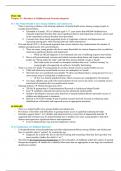Class notes
Chapter 15 - Disorders of Childhood and Neurodevelopment
- Course
- PSYC 300A
- Institution
- University Of British Columbia (UBC )
Explore lecture notes on Disorders of Childhood and Neurodevelopment. Gain insights into the complexities of childhood disorders, including ADHD, autism spectrum disorders, and learning disabilities. Examine diagnostic criteria, symptoms, and contributing factors. Discover evidence-based interventi...
[Show more]



